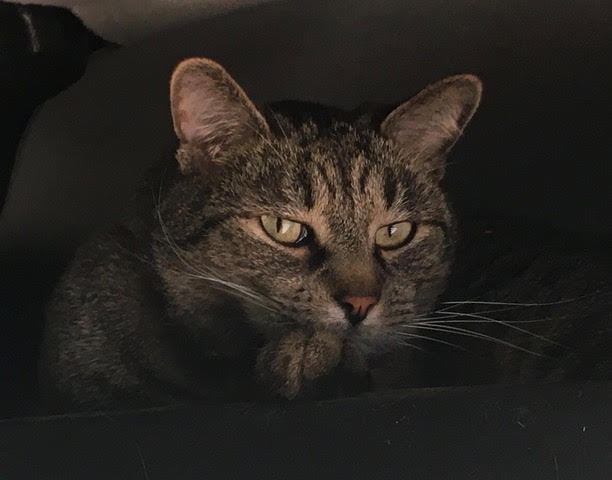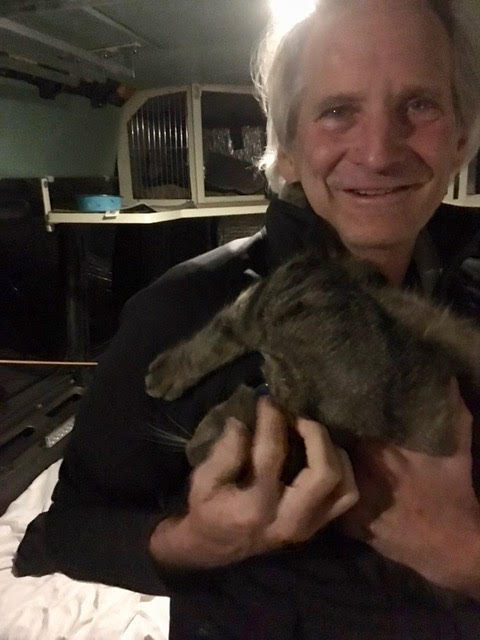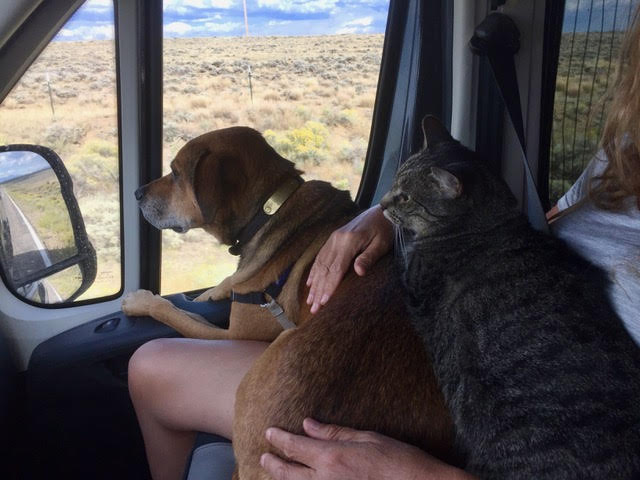 A few weeks ago, I started a long-anticipated, summer-long camping trip, with my dog Frances, my cat Lao, and my husband John joining us part of the time. One evening, we were in our camper van in an enormous meadow filled with wildflowers overlooking the Sangre de Cristo mountains.
A few weeks ago, I started a long-anticipated, summer-long camping trip, with my dog Frances, my cat Lao, and my husband John joining us part of the time. One evening, we were in our camper van in an enormous meadow filled with wildflowers overlooking the Sangre de Cristo mountains.
John had just rejoined us after a few days away, and Frances and I both went running out to greet him. Then John hopped in to the van to say hi to Lao, expecting him to come meowing. But there was no Lao.
I was immediately concerned: Lao loves to greet his daddy. We began whistling the Lao whistle around the van. Ordinarily he comes pretty quickly, often at a run. But no kitty appeared.
John didn’t say anything to blame me, but he asked an awful lot of questions as we looked. “When did you last see him? How far from the van did he go? How long did he stay out? Was Frances out too?” I couldn’t help but hear each question as really meaning, “Were you careful enough with him?” Lao was John’s cat when we met, and they were tight. Plus, John is generally more cautious about Lao being out than I am, checking on him more frequently. And the truth was that I’d been pretty absorbed in my work that afternoon.
Guilt seemed to coagulate into molasses in my brain, clogging my synapses. All I wanted to do was cry, but I tried to prod my brain back into action. What could have happened? A car might have hit him, but then we would have found his body. And it was such a big, open meadow — would a predator really have ventured out to get him in the middle of the day, with Frances around to boot? Maybe it had been a raptor — but didn’t they mostly hunt in the evening?
After three or four hours of looking for Lao, it got dark. John is the most optimistic person I know, but he was sitting in his car, alone, his head in his hands. “I think he’s gone,” he said.
Later, we sat in the van in misery together. It felt just awful to do nothing, especially looking at John’s crumpled face. But we were both worn out, and we’d already looked everywhere we could imagine. Then an idea occurred to me, a weird one: What about calling an animal communicator?
 I’d experimented once before with going to a psychic, and although I hadn’t been convinced of any paranormal activity, I’d found it extraordinarily useful (for that story, you’ll have to read my book, Through the Shadowlands: A Science Writer’s Odyssey into an Illness Science Doesn’t Understand.) And anyway, I figured, it had to be better than just sitting there doing nothing.
I’d experimented once before with going to a psychic, and although I hadn’t been convinced of any paranormal activity, I’d found it extraordinarily useful (for that story, you’ll have to read my book, Through the Shadowlands: A Science Writer’s Odyssey into an Illness Science Doesn’t Understand.) And anyway, I figured, it had to be better than just sitting there doing nothing.
But by then it was late — around 9pm. So I started Googling animal communicators in California, hoping to find someone who was still up and would do it right then. At first, I read through their websites, trying to find one who didn’t seem totally wackadoodle. I skipped the one who repeatedly emphasized that her fees were NON-REFUNDABLE. But as I failed to reach anyone available and the hour grew later, I stopped reading the websites at all, just scanning for a phone number.
After an hour of calling about 20 different animal communicators, one finally texted me back. “Is he black?” she asked.
“No. Gray tabby.”
“Green eyes?”
Well, maybe a little more yellow than green, but I supposed so.
She instructed me to pay up — $150 for a half hour — and then she’d call me.
When I went to her website, I quailed. For one thing, her name was Candi Cane Cooper. Though she was in her early 60s, she had the style of a 20-year-old, sporting bleached blonde hair and wearing gym clothes that showed off her physique. Am I really going to do this?
John seemed into it, though. Heck, I figured, if nothing else it would demonstrate to John that I really cared about finding Lao. And what if it worked?
I paid, and a few minutes later, she called. She asked us a few questions, and we mentioned that Frances had been outside with him. “Is Frances black?” she asked. Nope, brown.
She had us close our eyes and do a quick meditation, focused on letting negativity go and taking positivity in. I rather hate positive thinking, but I tried to let that negativity go too.
Then she tuned in to Lao. “He hasn’t crossed the rainbow bridge,” she said, using the favored euphemism among animal communicators for dying, one that struck me as so saccharine that I cringed. But I must admit — hearing that also made my heart lift. Slightly.
“He’s very very scared,” she said. “And he’s hungry, and his stomach hurts. He’s not far away.” Something had scared him, she explained, and he was hiding. John asked if he’d heard us calling, but she reported that he wasn’t sure. That wasn’t unusual, she said. When animals get too scared, they can’t really take anything in.
She asked us to talk to him through her, to say things that would calm him down. We crooned at him for all we were worth, telling him about how his daddy had gotten home to see him and how all his favorite things were waiting for him in the van and how we couldn’t wait to rub his ears just the way he likes. “Especially the right one!” Candi Cane reported. (News to me.)
It was working, she said. Now Lao’s stomach didn’t hurt. She asked him to show her images of where he was or what had happened. She decided that the black animal she’d been picking up on was what had scared him — a dog maybe. (Jeez, a dog?, I thought. There was some traffic on the road we were on, but I hadn’t seen any hikers, with or without dogs.) “He’s not going to want to go out of the van again for a loooooong time,” she said. “He’s way too scared by this.”
She reported things he was seeing: Something with circles, a whole bunch of circles, inside one another. A culvert, maybe?, we thought. A couple of culverts crossed the road, though they’d been Lao-less when we’d checked them earlier.
She kept going with images he was seeing: a triangle that was orange, or maybe almond-colored, about the size of a half-sandwich; something else like a construction cone. Were there any construction sites nearby? Nope, we said.
She asked us if Lao had a bell on his collar — yes. “Is it multicolored?” she asked, but no, it was just blue. “He really likes his collar,” she said. She reported that he was warm (surprising, because it was cold out at night at 10,000 feet) and that he wasn’t thirsty. Maybe that fit with him hiding in a culvert?
She told Lao that we were going to look for him and he should watch for our lights, and if he could be really brave and come out when he saw them, he’d get to come spend the night with us in the van with his daddy and his mommy and get his ears rubbed (especially the right one). But if he couldn’t, it was OK, because we’d come looking for him first thing in the morning, and we weren’t going to leave without him. And she reported that he wanted me to wear closed-toed shoes. I laughed: I’d been wearing Tevas as we’d looked for him, which was indeed a dumb choice of footwear.
After an hour on the phone (despite the half-hour payment), she sent us out to look for him. I dutifully put on my boots. The first culvert was empty, but I noticed something we’d missed earlier: Next to it was an older culvert that had mostly collapsed. It was a perfect hidey-hole for a frightened kitty. We shined our lights in and called and looked, but he didn’t come out, and we couldn’t see in very far. So we went to check the other culvert, a good distance away on the other side of the van — also empty.
As we were walking back, we each started to make the same comment: “Even if she was just making shit up, man, I sure feel better! At least now we’ll get a decent night of sleep, with some hope that we’ll find him in the morning.” Before we talked to Candi Cane, we’d both been convinced he was dead. But what she’d said about him hiding because he was scared just seemed so plausible. It now seemed far more likely than that some raptor had nabbed him in broad daylight. Surely in the morning we’d find him.
Just then, I heard a bell. I shined my light, and there was Lao, strutting toward us with his tail high, clearly looking for us, coming from the direction of the collapsed culvert. “I can’t believe it!” John cried. He scooped him up and held him by his face. “I can’t believe it! I can’t believe it!”
The moment felt even more surreal than the conversation with Candi Cane had. For all that I’d convinced myself that he must be hiding in that culvert, as I watched him writhing ecstatically in John’s arms, he still seemed like a ghost come back to life.
 So do I think Candi Cane Cooper really communicated psychically with our cat? To answer that, I need to explain a small piece of mathematics. Please excuse the geekery — I am a mathematician at heart.
So do I think Candi Cane Cooper really communicated psychically with our cat? To answer that, I need to explain a small piece of mathematics. Please excuse the geekery — I am a mathematician at heart.
Back in the mid-1700s, an amateur mathematician, the Reverend Thomas Bayes, addressed a really fundamental question: Given some experimental data supporting a hypothesis, how do you assess the probability the hypothesis is true? He made a radical claim about that, one that shocked other mathematicians and set off a controversy that’s lasted to this day. First, he said, you have to decide how likely you thought it was in the first place, before you did your experiment. That’s right — to make a mathematical assessment, you have to start with a subjective judgment, now called the “Bayesian prior probability.”
A few decades later, the decidedly non-amateur mathematician (and atheist) Pierre-Simon Laplace proved a beautiful mathematical theorem showing how, given a Bayesian prior, you could calculate just how likely the hypothesis is to be true now that you have your new evidence. That latter probability is known as the “Bayesian posterior.”
So that means that if I’m going to assess what the chances are that Candi Cane Cooper communicated with our cat, I have to start by deciding on my Bayesian prior: How likely did I think it was before I even met Candi Cane Cooper? Honestly, pretty darn unlikely. My prior might have been slightly higher than yours — after all, I had had that previous spectacularly useful encounter with a psychic that was at least not inconsistent with the idea that some kind of clairvoyance was going on — but still, it was very small.
If your prior is very small, the evidence would have to be spectacular to produce a large posterior. And in this case, if I’ve got my hard-nosed mathematician hat on, I have to admit that the experimental evidence here is far from spectacular. Despite the key things Candi Cane got right — particularly the fact that Lao was alive — she didn’t nail everything. Her only prediction about the future was actually flat-out wrong: Lao has been keen as ever to go out of the van, even trying to sneak out the open front window once when I stopped by the side of the road to make myself some coffee. Also, Lao is not black. Frances is not black. She said that something had chased Lao that was black, but that’s beyond determination. She reported that weird thing about circles, and we interpreted it as being a culvert, and well, maybe — Lao came from the direction of the collapsed culvert, but lots of things lay in that direction. The orange or almond colored triangle and the construction cone-like thing? Who knows. His collar was not multicolored. OK, it’s true that I needed to put on some damn boots — but it’s quite a stretch to imagine a cat being concerned about the state of my toes.
And most of what she got right she might have guessed from the situation. We had described the huge open meadow to her, and the reality was that the odds that he was hiding were much higher that that some predator had ventured 200 yards from the trees to nab him in broad daylight in front of a dog.
So even though Candi Cane was certainly tremendously helpful, when I’m being a hard-headed mathematician, I’m not so sure that this experience should change that Bayesian prior all that much anyway.
But I’d also point that small as the prior may be, it is not zero. I think it’s important to acknowledge that for two reasons: One is simple truth. But the other is that my experience is that holding the door open to weird possibilities expands your experience of the world in unexpected ways, and this experience is a good example of that. We got our cat back. Furthermore, even if what was happening wasn’t truly animal communication, it was pretty damn awesome and helpful, and it couldn’t have happened without the shared fiction (probably) that she was communicating with Lao. She was extremely effective at calming us down, and that made a huge difference in the situation. Before we called her, I was so absorbed by my guilt and worry and fear that I couldn’t seriously hold onto the possibility that he might be alive and couldn’t think clearly about how best to look for him. Without Candi Cane, we certainly would not have tromped out again that night, calling for Lao with genuine hope. And, who knows, maybe the hope in our voices helped Lao to calm down and pluck up the courage to emerge.
I’m definitely not saying that Candi Cane was lying when she said she was talking with Lao. My guess about what she did was that she really opened herself to her subconscious, saying whatever came to mind, kind of like a waking dream. Just as dream interpretation can be very useful even if dreams don’t predict the future, that process of free association can generate useful insights even if she wasn’t truly talking to animals. It also requires genuine skill. In a way, as writers, we’re doing the same thing, opening ourselves to our subconsciouses at the keyboard. That’s why even writers who are hard-headed mathematician types will talk about the Muse: It feels like it comes from beyond us. For Candi Cane, it feels like it comes from a cat. And even though I might calculate the posterior probability of that as being low, I sure can’t say she’s wrong.
 The thing is, I didn’t go to Candi Cane looking for her to prove the hypothesis that animal communication is literally real. I went to her to find my cat, and she sure did a magnificent job of that. I’m hugely grateful — and even though I’m not an animal communicator, I’m confident in my conviction that Lao, who is purring in my lap, is too.
The thing is, I didn’t go to Candi Cane looking for her to prove the hypothesis that animal communication is literally real. I went to her to find my cat, and she sure did a magnificent job of that. I’m hugely grateful — and even though I’m not an animal communicator, I’m confident in my conviction that Lao, who is purring in my lap, is too.
__________
Julie Rehmeyer is the author of Through the Shadowlands: A Science Writer’s Odyssey into an Illness Science Doesn’t Understand., a contributing editor at Discover magazine, and a Friend of LWON who freelances for the New York Times, Washington Post, Slate, Aeon, and many other publications.
_________
Photos by the author